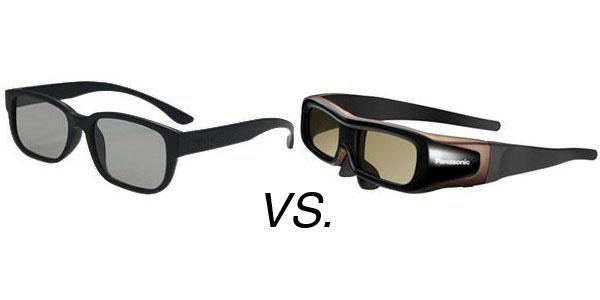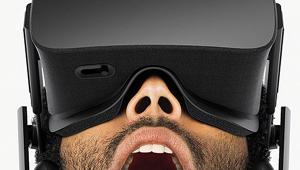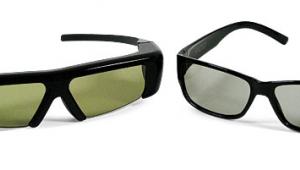Surviving The 3D Format War

How They Work
With active glasses, two slightly offset images, one each for the left and right eye, are flashed on the screen alternately at a very high frame rate. The LCD lenses in the glasses act like shutters; when one is open, the other is closed, ensuring that at any moment you're seeing only the left-eye or right-eye image. They flash so quickly, though, that your brain blends them to create a non-flickering 3D image. Either an IR sensor or a Bluetooth receiver in the glasses receives cues from the TV to keep the shutters properly sync'd.
Passive 3D technology is used in most commercial theaters; in fact, the new home 3D system uses the same type of glasses provided for RealD commercial presentations. These TVs use something called circular polarization to separate the left and right eye images. In a sense, the left and right images are "encoded" optically then decoded at your eyes by slightly different lenses matched to each. The result is that only the left-eye image passes through the left eye's lens and vice versa. Unlike the alternating images of an active 3D system, both the left and right eye images of a passive 3D TV are displayed simultaneously on the screen, which accounts for some critical differences discussed below.
Resolution & Detail
Since active 3D uses the full 1080p screen resolution for each eye's image, it lays claim to delivering the greatest level of detail in 3D mode. With passive 3D, which displays both eye's images on screen at once, only half of the screen's available pixels are used for each eye, effectively cutting the vertical resolution for each eye in half. In Home Theater's tests of passive 3DTVs, we've found the visible effect of this much less noticeable than you'd think on 3D Blu-ray Discs, but it's there. In addition, passive 3DTVs display fine, dark horizontal lines on the screen that separate the left and right eye images. These are reminiscent of the scan lines that become visible if you get too close to the screen of a traditional tube television. As with scan lines, these grid lines become less noticeable or disappear as you step back, so your seating distance from the screen may be a factor in your decision whether to get a passive or active 3D system.
On the plus side, passive glasses generally provide a wider horizontal viewing angle to better allow 3D viewing from off-center seating. However, the vertical viewing angle is much narrower, and you see lots of "ghosting" (the left and right images are visible in both eyes) if you watch 3D while lying on the floor.
Cost & Weight of Glasses
Here's where passive trumps active in a big way. Since passive glasses don't require a battery and circuitry to operate, they are lighter and tend to be more comfortable over long periods. Obviously, they don't require battery replacement or recharging, either. They're also less delicate: although the LCD lenses on active glasses are pretty durable, you do have to take some care with them, a consideration for families with young children. And, oh boy, do passive glasses ever cost less: compare $50 to $150 per pair for active glasses to less than $10 each for passive, or even $0 if you're not beyond heisting a pair after your next RealD 3D movie outing. (Imax 3D glasses won't work with passive 3DTVs at home.) It is primarily this ability to cheaply spread the 3D wealth to the whole family that makes passive 3D so compelling for the home and has driven manufacturers to face off in the marketplace.
Headaches, etc.
Some viewers are bothered by headaches, eye fatigue, nausea, or worse when viewing 3D content. Passive glasses aren't a cure-all for this, but in the home environment, some people do better with passive glasses than with active, possibly because there's no brief blackout period during which both lenses are off, as happens when active shutter lenses cycle from eye to eye.
You'll have to look at both types of 3D in the store to make your own decision, but in the end, you'll want a great 2D TV first and foremost. If you take image quality seriously and follow Home Theater's recommendations, you might end up with a plasma over an LCD, in which case your decision will be made: no 3D plasma currently offers the passive 3D option.

















































